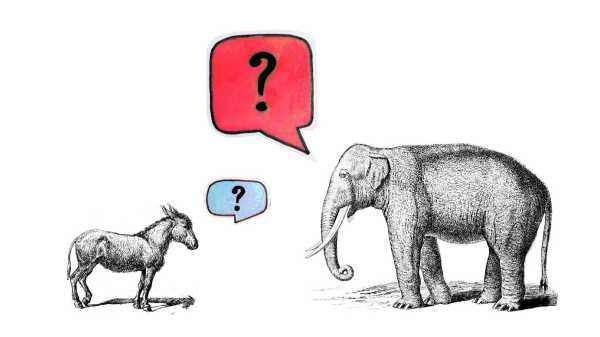
Part of The 2022 midterm elections, explained
What questions do you have about the state of the Democratic Party?
Vox senior politics reporter Christian Paz is here to help you unpack the fractured American political system and how it affects your life. Submit your question here.
Election Day 2022 is almost here. On Tuesday, millions of voters will decide control of Congress, state houses, governor’s seats, and local offices as well as new policy through ballot initiatives in the 2022 midterm elections.
We won’t know the results of every election — including some big ones — by the time Wednesday morning rolls around, due to varying deadlines for ballot-counting. But when all is said and done, we’ll finally have the answers to eight key political questions that have vexed us this cycle and a better understanding of the trends that will shape American politics in the years to come.
1) Is it as simple as “the economy, stupid”?
Look at just about any poll and you’ll consistently find that the state of the economy, and specifically high inflation, is the top concern of American voters. The share of voters this year who told Gallup the economy was “extremely important” to them (about 49 percent) has not been this high since 2010, the midterms after the Great Recession.
Those concerns aren’t unfounded: Though unemployment remains near a historic low, inflation was still at 8.2 percent in September compared to a year ago, despite aggressive action from the Federal Reserve to tamp down consumer demand with interest rate hikes. And in battleground states around the country, rising costs of living, including finicky gas prices, registered as top concerns throughout the summer and fall — though there was a brief period starting after the leak of the Supreme Court’s intent to overturn Roe v. Wade when abortion rights rivaled economic concerns as the top issue in voters’ minds.
The math is simple if you only consider economic issues: Since Republicans have a significant lead among voters who rank the economy as a top concern, Democratic candidates in statewide and congressional races, especially if they are incumbents, stand to bear the brunt of voters’ anger, fear, and frustration with the economy. That’s why so many strategists fall back on the idea of “the economy, stupid”— an easy reminder coined by former President Bill Clinton’s strategist James Carville — that incumbent leaders are weakest when hammered on economic conditions. That dynamic is apparent in the states with the tightest Senate and gubernatorial contests like Arizona, Nevada, and Georgia. Democratic incumbents in each of those states are practically tied with Republican challengers who have zeroed in on inflation as their primary attack.
But two other issues — crime and abortion — have also dominated the last few months, providing political boosts to the parties voters most trust to handle them. The strength either party has gained from these issues has also depended on economic outlook: As gas prices eased in late summer, Democrats’ and Joe Biden’s approval rose. But a dip in the markets and an uptick at the pump in the fall have pressured voters and refocused their attention on who they see as being in charge — and at fault.
Politicians, especially incumbents, haven’t usually been able to outrun bad economic news — Obama’s reelection in 2012 was one exception after a slow post-recession recovery. Whether voters care about anything more than pocketbook pain will get tested on Tuesday.
2) Is there any running away from an unpopular president?
The polls also all point to another fact: Joe Biden is very unpopular right now, especially in swing states, in large part due to how upset voters are with his handling of the economy and his leadership in general.
The president’s approval rating remains low, with about 53 percent of Americans disapproving of his job performance, according to FiveThirtyEight. And those numbers look worse state by state: About 6 in 10 likely voters disapprove of Biden in Arizona, Nevada, Pennsylvania, Michigan, and Wisconsin.
Political experts and pundits have long expected Biden to be a drag on Democratic candidates across the country because of the midterms normally being a referendum on the president’s party, Biden’s historically low ratings, and the constant bad economic news this year has delivered. Those factors compound in the closest House races, where Republicans seem more energized to vote and Democrats have more vulnerable seats to defend.
3) How much of a boon — or a drag — is Donald Trump?
In post-presidency polling, more than half of voters polled continue to dislike former President Donald Trump (about 52 percent, like Biden). Before the 2018 midterms, Trump had the same level of disapproval as Biden did — fueling a blue wave election.
This year, the former president played a major role in shaping general elections, intervening in primary contests in every battleground state to elevate candidates firmly in line with his movement, including those who deny the results of the 2020 election. His preferred candidates ended up winning in most races, including in the closest Senate and gubernatorial contests of the year, like Arizona, Pennsylvania, and Nevada. They typically possess some combination of political inexperience, personal scandal, and right-wing ideology that opened them up to attacks and alienated independent voters — making their races more competitive for Democrats than they’d otherwise be.
In the general election campaign, Trump has exerted a lot of energy rallying with these candidates. He made visits to Arizona, Florida, Ohio, Nevada, and Pennsylvania, and hinted last week at an Iowa rally that he was planning to make an announcement about 2024. His talk of running again has been strategic: Were he to formally announce a reelection effort earlier this year, he likely would have trained even more Democratic fire on vulnerable Republican candidates.
Waiting until after the midterms are over helps Trump avoid culpability if some of those candidates lose, while victory in those races would confirm his status as a kingmaker and the de facto Republican nominee. CNN reported as much last week, citing advisers close to Trump who say the former president views the final days of the midterms as a runway to “carry embattled Republicans to victory” and eventually relaunch his own campaign. Essentially, it’s looking like Trump did matter for his chosen candidates; the reception to his candidacy will tell us just how much power he still wields.
4) How potent is abortion as a political motivator?
Though the economy remains the predominant issue, abortion rights still rank highly on the minds of voters — especially among Democrats, liberals, women, and college-educated voters.
In the wake of the Supreme Court ending the national constitutional right to an abortion, it seemed the issue, combined with policy wins this summer, was powering a Democratic surge in the polls. In August, an overwhelming victory (and huge turnout) batting down a Kansas referendum that would have allowed for abortion restrictions confirmed the power of running on protecting abortion rights, and, paired with a victory in an upstate New York special congressional election, it made it seem as if the tide might be turning for Democrats.
But that Democratic optimism, and the strength of abortion rights as a motivator in the face of strong economic and social headwinds, may have peaked too soon.
Purple battleground states (like Arizona, Georgia, Michigan, Pennsylvania, and Wisconsin) where reproductive rights are under assault, were temporarily banned, or stand to be restricted by legislatures without Democratic governors feature either extremely close congressional or toss-up governor’s races where Democrats have zeroed in on abortion rights as a way to attack Republicans. In Michigan, for example, Gov. Gretchen Whitmer may benefit from her Republican opponent’s hard-line stance on abortion: While 40 percent of voters rank inflation as their top concern, 31 percent prioritized abortion rights. Similar dynamics are playing out in Pennsylvania and Wisconsin’s governor races.
In other states where abortion rights are protected to some degree, the issue is looking less potent. Nevada, for example, codified protections for abortion until 24 weeks of pregnancy through a 1990 referendum, and nearly 90 percent of residents support some degree of access to abortion. Democratic incumbents have made the matter a central part of their campaign: Sen. Catherine Cortez Masto has called her Republican opponent an “automatic vote” for a federal abortion ban, and Democratic Gov. Steve Sisolak has tried to force his opponent to defend restrictions on abortion in the state. But those messages have been muddled by the current state protections, by Republican candidates’ strategic silence or evasion of the topic, and by the strong headwinds of the economy.
Abortion rights will also be on the ballot in referenda in Alaska, Kentucky, and Montana, as well as a perfunctory vote in California to add abortion rights to the state constitution (state law already protects access). These statewide votes will provide a clearer answer on the salience of abortion rights among the general public — even if it isn’t a big motivator for electing specific politicians. If these referenda lead to big turnout, as was the case in Kansas, they could offer future road maps for progressive activists and liberal politicians hoping to protect abortion rights in post-Dobbs America.
5) How accurate are the polls?
The polling error hangovers of 2016 and 2020 are still with us, and with good reason: Polling has gotten more difficult to conduct, the bias of who participates in polling still exists, and the price of commissioning and running those operations has grown. The result is that the 2022 elections have had fewer state and individual polls conducted than any midterms year since at least 2010, according to FiveThirtyEight.
Some outlets, like the New York Times and, ahem, Vox, have warned about the possibility that polls this year might be off, especially reflecting too big of a boost late this summer for Democrats. In 2016 and 2020, polls suffered from low-response rates from Trump supporters and undecided voters who made up their minds in the final days of the elections; pollsters didn’t expect to see such a strong tie between college education and partisanship, and because they couldn’t predict the makeup of the eventual electorate, they failed to weight the results they got properly. My colleague Andrew Prokop has written about what this might mean for elections this year, and you should read that if you’re worried, but the bottom line is that while polling is an inexact science (3 percent polling errors are normal), they are still the best quantitative way for experts, journalists, and laypeople to get a sense of what’s going on in an electorate.
All this is to say that you should approach polls, especially those released in the final days of the campaign, with caution. State-by-state polling has consistently overrated Democrats’ performance. And especially in states where it is hard to conduct polling (Nevada, Wisconsin, and plenty of solidly red states, for example), results often understate the degree of Republican motivation.
After election night, we’ll know by just how much the polls were wrong and, more importantly, how they were wrong. That will allow pollsters to sharpen their models for the next cycle. That won’t be an easy task — pollsters will likely have to figure out new ways of reaching voters to have better samples, specifically of Republicans, those without college educations, Latinos, and other voters of color (who are frequently underpolled and undersampled).
6) Does candidate quality matter?
One of the most visible concerns Republicans (and, to a much lesser extent, Democrats) had this cycle was frustration with the kind of candidates they put up in competitive races. Due to former President Donald Trump’s promotion of imperfect or inexperienced loyalists, “candidate quality” entered the national conversation even before Senate Minority Leader Mitch McConnell fretted aloud in August that flawed candidates might cost Republicans control of the Senate.
Republicans’ fear has centered on Herschel Walker in Georgia, Blake Masters in Arizona, Mehmet Oz and Doug Mastriano in Pennsylvania, and, to a lesser extent, J.D. Vance in Ohio and Adam Laxalt in Nevada — all candidates who have no political experience, have embroiled themselves in scandal, espouse far-right political stances, lack the charm or gravitas of other Republican candidates, or all of the above.
Two phenomena will determine how much of a setback these candidates will be for the GOP: ticket-splitting and the nationalization of politics.
Some statewide contests have seen big polling gaps between candidates of the same party: In Georgia, for example, Gov. Brian Kemp is polling far better than Walker; in Ohio, Gov. Mike DeWine is running way ahead of Vance; in Arizona, gubernatorial candidate Kari Lake is performing better than Masters. Some of that is likely due to voters not feeling strong allegiance to these candidates, and opting to do something they haven’t done in a while: make an exception in their straight party-line vote choices.
But because state and local politics have become more entwined with national politics, many voters, including the most partisan kind (who tend to vote in midterms), will in the end vote for a party and not a candidate. Biden’s low approval rating will compound this dynamic, but as Ron Brownstein wrote last week at CNN, there is a not-insignificant chunk of voters in these states who disapprove of Biden and national Democrats but also view Republican Senate candidates unfavorably: “9% in Wisconsin, 11% in Nevada, 13% in Pennsylvania and 15% in Arizona, according to detailed results provided by the CNN polling unit.”
In other words, the GOP’s candidates are making this race a referendum on whether voters weigh persona or party more heavily.
7) Are Latino voters really shifting right?
This perennial question grew louder after Republican improvements among Latino voters in 2020, and again when Republicans sustained some of those gains among Latinos during off-year elections in 2021.
Democrats are still expected to win a large majority of Latino voters: This summer, Pew Research found that nationally, 53 percent of Latino voters planned to vote for a Democrat in congressional elections, while 28 percent were backing Republicans. Nearly 20 percent were undecided or looking at a third party. This year, Democrats seem to be suffering losses of Latino support driven by the country’s economic condition more than Republicans seem to be gaining among these voters — more a case of gradual erosion of support rather than a complete generational shift.
But Republicans have gained a foothold among Texas and Florida Latinos, where large, consistent investments in outreach and candidate recruitment have helped solidify gains. Election night results will likely give us a final answer on how durable these Republican efforts were but do not extrapolate national trends from these two unique places. Look to places like Arizona, Southern California, Nevada, and suburban Virginia for additional evidence of a red or blue shift among Latinos. In these places, however, turnout and results might say more about the lack of enthusiasm for Democrats than about Republican successes in courting these voters. The latter would be better news for Democrats, and offer a road map for winning back credibility on kitchen-table issues — especially affordability.
Tuesday’s results will either confirm a rightward trend among Latino voters in specific states — or show that the last two years may have been anomalies.
8) Do voters care about the threats to democracy?
Nearly every state in the country features election deniers on the ballot, including 238 Republican House candidates, 20 GOP Senate and gubernatorial candidates, and 12 secretary of state contests, according to a CBS News analysis. And that means election integrity, voter participation, and the free and fair operation of future elections are on the line.
Governors and secretaries of state are especially important in swing states like Arizona, Nevada, and Pennsylvania, where those offices have sway over the 2024 elections. Democrats in those contests have tried to make Republican efforts to overturn 2020 election results central to their pitches — and Biden’s closing argument, delivered last week, also centered on the threat to democracy these Republican candidates pose.
Democrats have also tried to make the January 6 insurrection a core part of their attacks on Republican candidates in Arizona and Nevada to mixed results, while House candidates have struggled to make it a salient issue, even in the places you’d expect to be most open to that message.
Though voters have said in polling they are concerned about election deniers, the legacy of January 6, and Republican efforts to subvert the legitimacy of elections, these threats to democracy may not outweigh the primary economic and social concerns most voters have.
We’ll get proof of this Tuesday night — while also getting a better understanding of what messages do and don’t work to convince voters of these threats.
Help keep articles like this free
Truly understanding the chaos in America’s political sphere can be overwhelming. That’s where Vox comes in. We aim to give research-driven, smart, and accessible information to everyone who wants it.
Reader gifts support this mission by helping to keep our work free — whether we’re adding nuanced context to unexpected events or explaining how our democracy got to this point. While we’re committed to keeping Vox free for all, our distinctive brand of explanatory journalism does take a lot of resources. Advertising alone isn’t enough to support it. If you’re in a position to do so, support our mission and help keep work like this free for all by making a gift to Vox today.
Sourse: vox.com






